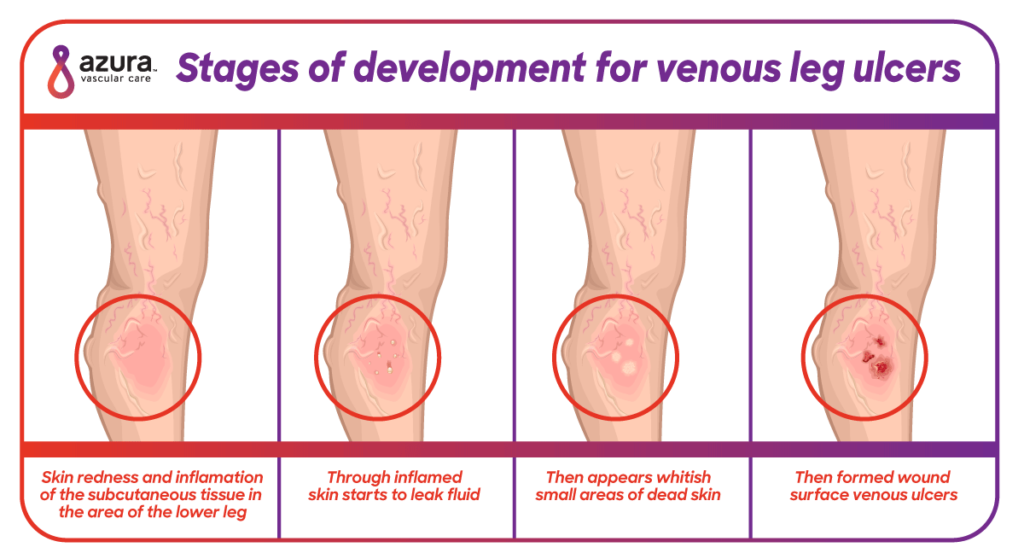
You may think of varicose veins as merely a cosmetic nuisance but your varicose veins could be a symptom of a more serious venous condition. If you have swollen leg veins or a heavy, aching sensation in the legs, don’t ignore these signs. They could be symptoms of chronic venous insufficiency. A vascular specialist can determine whether you’re at risk for this condition. If you do have chronic venous insufficiency, treatment can help relieve your symptoms and may prevent complications.
What Is Chronic Venous Insufficiency?

Chronic venous insufficiency is a vascular condition that affects the legs. The veins in your body are equipped with valves that keep blood flowing in the right direction. Sometimes, these valves may not work correctly. If the valves in your leg veins don’t work well, blood can flow backward and pool in the legs. (i) Over time, this can lead to swelling, discoloration, and open sores called venous leg ulcers, which may become infected. (ii)
Chronic venous insufficiency is often confused with varicose veins. It’s true that many people with chronic venous insufficiency have visible varicose veins on their legs. But not everyone with varicose veins goes on to develop chronic venous insufficiency. (iii) If you’re concerned about your varicose veins, a vascular specialist can perform tests to check for chronic venous insufficiency.
Chronic Venous Insufficiency Symptoms
One of the earliest symptoms of chronic venous insufficiency is varicose veins. These veins typically appear in the lower legs. Varicose veins symptoms can include: (iv)
- Dark blue or purple veins
- Twisted or bulging veins
- Sore, achy legs
As chronic venous insufficiency progresses, patients may also experience the following symptoms in their legs: (v)
- Aching sensation
- Heaviness
- Itching
- Bruising
- Swelling
- Brownish skin
- Eczema
- Ulcers
 In its later stages, chronic venous insufficiency often causes changes in the texture of your skin. Your lower legs may look blistered or scaly. You might also have open sores that bleed or weep. (v)
In its later stages, chronic venous insufficiency often causes changes in the texture of your skin. Your lower legs may look blistered or scaly. You might also have open sores that bleed or weep. (v)
Early symptoms of chronic venous insufficiency, like achy legs, might not seem serious. If left untreated, the condition may progress. Serious complications can arise from untreated chronic venous insufficiency.
Chronic Venous Insufficiency Complications
Venous Ulcers
Poor circulation in the legs can cause ulcers to develop. These ulcers may be painful and slow to heal. Even with treatment, it can take months for an ulcer to disappear. If they’re not kept clean during the healing process, these ulcers can quickly become infected. (ii)
If a venous ulcer becomes infected, your doctor may need to debride the wound to remove infected tissue. (vi) You may also need to take oral antibiotics. Infected ulcers must be treated right away. An untreated infection may require surgery. (vi) However, swift treatment can usually resolve the infection and prevent further complications.
Blood Clots
Reduced blood flow in the legs can also trigger the formation of blood clots. Chronic venous insufficiency is sometimes linked to deep-vein thrombosis (DVT). (i) DVT develops when a blood clot forms in one of the deep veins in your legs. These clots can block blood flow to the leg and in some cases, may cause a pulmonary embolism. (vii) Pulmonary embolisms can occur when part of a blood clot in the leg breaks off and travels to the lungs. The clot can then block the arteries in your lungs and keep you from getting enough oxygen. Pulmonary embolisms can be fatal. (vii) Symptoms of pulmonary embolism include coughing up blood, feeling pain or discomfort in the chest, experiencing shortness of breath, and having low blood pressure and an elevated heartbeat. (vii) If you suspect a pulmonary embolism, call 911 immediately.
Bleeding
Circulation problems can affect your ability to heal from injuries. If you have chronic venous insufficiency and injure your leg, you may bleed heavily. Immediate care might be needed to stop this bleeding. Uncontrolled blood loss can sometimes be life-threatening.
Some people with chronic venous insufficiency may bleed spontaneously. (iii) This might occur due to a venous ulcer or a hemorrhaging vein. Any unexplained or heavy bleeding should be reported to a doctor right away.
Understanding Your Treatment Options
Chronic venous insufficiency symptoms are often painful. They may limit your ability to keep up with your job or other daily activities. The condition can also lead to dangerous health complications. But early treatment can help keep your veins healthy for as long as possible.
If you’re diagnosed with chronic venous insufficiency, you have several treatments options. Some chronic venous insufficiency treatments involve lifestyle changes. Others may require minimally invasive procedures or more extensive treatment to resolve venous ulcers or other complications. A vascular specialist can help you develop a treatment strategy that meets your needs.
Noninvasive Treatments
Noninvasive treatments can help make you more comfortable. They can also help prevent your condition from becoming worse. Many noninvasive treatments focus on managing symptoms and reducing pain. Your doctor may suggest that you: (viii)
- Elevate your legs

- Wear compression stockings
- Get regular exercise
- Maintain a healthy weight
- Avoid sitting/standing for long periods
It’s essential that people with chronic venous insufficiency maintain good hygiene and care for the skin on their legs. If you experience scaling, itching, or flaking skin, your doctor may recommend special topical creams to ease these symptoms. Your doctor will also tell you how to care for venous ulcers to promote healing and prevent infection.
Minimally Invasive Treatments
If noninvasive treatments aren’t providing enough relief, however, your doctor may recommend a minimally invasive procedure to improve blood flow to the legs.
These minimally invasive treatments can be performed in an outpatient setting: (viii)
These procedures work to address the underlying cause of chronic venous insufficiency: malfunctioning valves in the veins. These treatments close off the affected veins, causing them to shrink and disappear. (i) Blood flow is then redirected to healthy veins.
Chronic venous insufficiency symptoms can be alarming but prompt treatment may prevent complications and get you back on your feet. Call 844-832-VEIN (8346) to schedule an appointment with a vascular specialist today.
Sources:
(i) John Hopkins Medicine. (n.d.). Chronic venous insufficiency. Retrieved October 1, 2018, from https://www.hopkinsmedicine.org/healthlibrary/conditions/cardiovascular_diseases/chronic_venous_insufficiency_85,P08250.
(ii) MedlinePlus. (2016, May 24). Venous ulcers – self-care. Retrieved October 1, 2018, from https://medlineplus.gov/ency/patientinstructions/000744.htm.
(iii) Alguire, P. & Scovell, S. (2018, May 29). Overview and management of lower extremity chronic venous disease. In K.A. Collins (Ed.), UpToDate. Retrieved October 1, 2018, from https://www.uptodate.com/contents/overview-and-management-of-lower-extremity-chronic-venous-disease?csi=6430313b-0a6d-4266-b271-4024b76c9add&source=contentShare.
(iv) Mayo Clinic. (2017, December 28). Varicose veins: Symptoms & causes. Retrieved October 1, 2018, from https://www.mayoclinic.org/diseases-conditions/varicose-veins/symptoms-causes/syc-20350643.
(v) Moneta, G. (2018, April 19). Classification of lower extremity chronic venous disorders. In K.A. Collins (Ed.), UpToDate. Retrieved October 1, 2018. https://www.uptodate.com/contents/classification-of-lower-extremity-chronic-venous-disorders?csi=cc3253bf-f8bb-4f0e-a8f8-7a6bd7513422&source=contentShare%20.
(vi) Grey, J. E., Harding, K. G., & Enoch, S. (2006). Venous and arterial leg ulcers. The BMJ, 332(7537), 347-350. doi:10.1136/bmj.332.7537.347.
(vii) Center for Disease Control and Prevention. (2018, April 18). Venous thromboembolism (blood clots). Retrieved October 1, 2018, from https://www.cdc.gov/ncbddd/dvt/facts.html.
(viii) Mayo Clinic. (2017, December 28). Varicose veins: Diagnosis & treatment. Retrieved October 1, 2018, from https://www.mayoclinic.org/diseases-conditions/varicose-veins/diagnosis-treatment/drc-20350649.



